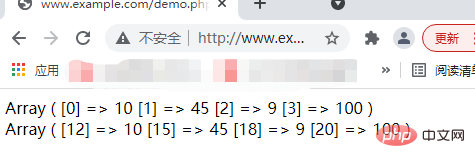Home >Backend Development >PHP Tutorial >How to delete the first and last elements in the array in PHP array operation?
In the previous article "How to solve the problem of sorting and disrupting arrays in PHP? 》Introduces the relevant knowledge of array sorting in PHP in detail. In this article, we will take a look at the relevant knowledge of deleting the head or tail elements of an array in PHP. I hope it will be helpful to everyone!

In the previous article we learned that if you want to sort multiple arrays, you can use the array_multisort function. If you want to sort the elements in the array If you want to shuffle, you can use the shuffle function. These are common operations in array operations. Let's take a look at how to delete the first element in the array or delete the array in PHP. the last element in .
The array_shif function is built-in in PHP to delete the first element in the array, and the array_pop function is used to delete the last element in the array, as follows Let's take a look at the usage of these two functions separately. Although they both delete elements, these two functions are different from the unset function and the array_splice function. The two functions introduced in this article do not need to know the key values and key names of the array elements.
<strong><span style="font-size: 20px;">array_shif</span></strong>Function-Delete the first element of the array
In PHP, you can use the array_shif function to delete the first array element. The basic syntax format of the array_shif function is as follows:
array_shift(array)
You need to pay attention to this is:
Parameterarray represents the array that needs to be deleted. After the function runs successfully, the result returned is the value of the deleted element. If the function runs unsuccessfully, The returned result is NULL. If the key name in the array is a number, the key name will be reassigned after the element is deleted through the function, starting from 0 followed by 1 and so on.
Let’s take a look at the use of the array_shift function through an example. The example is as follows:
<?php $num = array(10, 45, 9, 100, 6); array_shift($num); //删除数组开头的第一个元素 print_r($num); ?>
Output result:

In the above example, the first element in the array element is deleted through the array_shift function. Let’s take a look at what will happen to the output result if the key name in the array is a number. What is the impact? The example is as follows:
<?php $num = array(10, 45, 9, 100, 6); array_shift($num); //删除数组开头的第一个元素 print_r($num); echo '<br/>'; $num1 = array(12=>10, 15=>45, 18=>9, 20=>100, 22=>6); array_shift($num1); //删除数组开头的第一个元素 print_r($num1); ?>
Output result:

As can be seen from the above example, when the key name in the array is numeric When deleting the first array element through the array_shift function, the key name will be assigned again starting from 0.
We learned above that we can delete the first element in the array through the array_shift function, then let’s take a look at how to delete the array through the array_pop function The last element in the element.
<strong><span style="font-size: 20px;">array_pop</span></strong> Function - Remove the last element
in Similar to the array_shift function in PHP, we can delete the last element in the array element through the array_pop function. The basic syntax format of the array_pop function is as follows:
array_pop(array)
What needs to be noted is:
The parameter array is the array that needs to be deleted. If the function is executed successfully, the result returned is the deleted element. , if the array is empty or the parameter is not an array, the returned result is NULL.
Let’s take a look at the use of the array_pop function through an example. The example is as follows:
<?php $num = array(10, 45, 9, 100, 6); array_pop($num); //删除数组最后的一个元素 print_r($num); ?>
Output result:

The above example is to use the array_pop function to delete the last element in the array,
and then use the array_shif function to delete the last element in the array. When an element, we learned that when the key name of the array is a number, the key name will be reassigned, then when we use the array_pop function to delete the last element of the array, if If the key name of an element in the array is a number, will the key name be reassigned?
Let’s verify it through an example to see if the array_pop function will have an impact on the numeric key name. The example is as follows:
<?php $num = array(10, 45, 9, 100, 6); array_pop($num); //删除数组最后的一个元素 print_r($num); echo '<br/>'; $num1 = array(12=>10, 15=>45, 18=>9, 20=>100, 22=>6); array_pop($num1); //删除数组最后的一个元素 print_r($num1); ?>
Output result:

Through the above example, we can find that deleting the last element in the array through the array_pop function will not be reassigned when a number is the key name like the array_shif function. Key name. array_popThe function does not reassign key names.
If you are interested, you can click on "PHP Video Tutorial" to learn more about PHP knowledge.
The above is the detailed content of How to delete the first and last elements in the array in PHP array operation?. For more information, please follow other related articles on the PHP Chinese website!